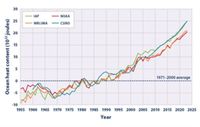As the world grapples with the escalating climate crisis, recent developments highlight a sobering reality: the planet is warming faster and in more dangerous ways than previously understood. From Pakistan’s urgent plea against plastic pollution to record-breaking global temperatures and unprecedented ocean heatwaves, the evidence paints a stark picture of environmental peril demanding immediate action.
In Pakistan, the World Wide Fund for Nature (WWF-Pakistan) has issued a pressing call for the government to impose an immediate and nationwide ban on all single-use plastics. This demand, made during the global Plastic-Free July campaign in July 2025, underscores the severe environmental and public health risks posed by plastic waste. The organization linked plastic pollution directly to the recent catastrophic monsoon flooding that claimed over 280 lives and devastated infrastructure across the country.
WWF-Pakistan emphasized that floating plastic waste is a major culprit behind the prolonged urban flooding, as it clogs drainage systems and causes long-term waterlogging. This blockage has led to structural damage to roads, buildings, and bridges, while stagnant water in affected areas has triggered outbreaks of waterborne diseases, further endangering public health. “Plastics break into microplastics, damage soil fertility, and pollute rivers like the Indus,” explained Hammad Naqi Khan, WWF-Pakistan’s Director General. He highlighted how plastic waste from Pakistan’s upper riparian regions flows downstream, harming freshwater and marine ecosystems, including biodiversity along the Arabian Sea coast.
The problem is global. A 2022 report by the Organization for Economic Cooperation and Development (OECD) revealed that worldwide plastic production nearly doubled from 234 million tonnes in 2000 to 460 million tonnes in 2019. Microplastics, the tiny fragments resulting from plastic degradation, now contaminate air, water, food, and even human organs, including lungs and the placenta of newborns. WWF-Pakistan is actively combating this crisis through advocacy, cleanup drives, and innovative recycling projects, such as training over 50 women in Karachi and Islamabad to recycle multi-layered plastics into marketable products.
Meanwhile, the global climate emergency has reached new heights in 2024, shattering previous temperature records. The World Meteorological Organization’s April 2025 climate report confirmed that the first quarter of 2024 was the hottest on record, with global average temperatures 1.56°C above pre-industrial levels—alarmingly close to the critical 1.5°C threshold outlined in the Paris Agreement. Europe experienced its warmest winter ever, while South America suffered unprecedented heatwaves, leading to failed crops and deadly wildfires.
Antarctic ice loss has accelerated dramatically, with the British Antarctic Survey reporting a loss of over 2,700 gigatons of ice between 1993 and 2023, 2024 being the worst year yet. The Intergovernmental Panel on Climate Change (IPCC) now projects that sea levels could rise by as much as one meter by 2100, significantly higher than previous estimates. Coastal cities like Miami and Jakarta are already facing frequent flooding even without storms.
Extreme weather events are becoming the new normal. The United States endured 28 billion-dollar disasters in 2024, breaking the previous record. India’s longest heatwave saw temperatures soar above 48°C in New Delhi for over a week, while floods in Brazil displaced over half a million people. Globally, one million species are at risk of extinction, with climate change surpassing habitat loss as the leading threat for many. The Amazon rainforest’s deforestation spiked by 30% in 2024, and coral reefs like the Great Barrier Reef have suffered repeated mass bleaching events.
The oceans, which absorb 90% of the excess heat from greenhouse gases, are undergoing unprecedented stress. A groundbreaking study published in ScienceDaily in July 2025 revealed that massive ocean heatwaves persisted for over 500 days starting in 2022-2023, covering nearly 96% of the world’s oceans. This phenomenon is considered a potential climate tipping point, signaling a “new normal” for ocean temperatures, according to Earth systems scientist Dr. Zhenzhong Zeng.
These marine heatwaves have devastating effects on marine life, causing oxygen depletion and mass fish deaths, as witnessed in western Australia where temperatures 5°C above normal killed tens of thousands of fish in early 2025. Such heatwaves have lasted four times longer than historical records and have multiplied twentyfold in frequency due to climate change. The oceans’ diminished capacity to absorb heat means terrestrial temperatures will rise even faster, intensifying droughts, wildfires, and storms worldwide.
Moreover, ocean heat is destabilizing the Greenland and Antarctic ice sheets, which contain enough freshwater to raise sea levels by 7.5 and 58 meters respectively if fully melted. Warm ocean currents are eroding glaciers and ice shelves, accelerating ice loss. In November 2024, 450 polar scientists issued an emergency warning about the rapid transformations occurring in these regions, urging an immediate halt to fossil fuel emissions to avert catastrophic sea-level rise.
Despite this mounting evidence, the U.S. Energy Department released a controversial report in July 2025 challenging mainstream climate science. The report, titled “A Critical Review of Impacts of Greenhouse Gas Emissions on the U.S. Climate,” was commissioned by the Trump administration and authored by prominent climate skeptics. It argues that sea level rise is not accelerating and claims rising carbon dioxide benefits plant growth, downplaying the severity of climate risks.
Climate scientists have criticized the report as a “scattershot collection of oft-debunked skeptic claims.” The report’s quick assembly and selective use of data stand in stark contrast to the comprehensive, peer-reviewed National Climate Assessments produced over years by hundreds of scientists. Environmental advocates view this as part of a broader campaign by the administration to undermine climate science and roll back regulations aimed at reducing greenhouse gas emissions.
As the planet faces a rapidly closing window to limit warming below dangerous thresholds, the stakes have never been higher. The economic costs of climate disasters soared to an estimated $650 billion in 2024, nearly doubling from 2022, with low-income nations bearing the brunt. The United Nations warns that without drastic emissions cuts, climate displacement could surpass 200 million people by 2050, fueling humanitarian crises and geopolitical tensions.
From Pakistan’s fight against plastic pollution exacerbating floods to the global surge in temperatures, ocean heatwaves, and ecological collapse, the evidence demands urgent, coordinated action. The climate crisis is no longer a distant threat—it is reshaping ecosystems, economies, and communities worldwide right now. The challenge ahead is immense, but so is the opportunity to steer the planet toward a more sustainable and resilient future.


